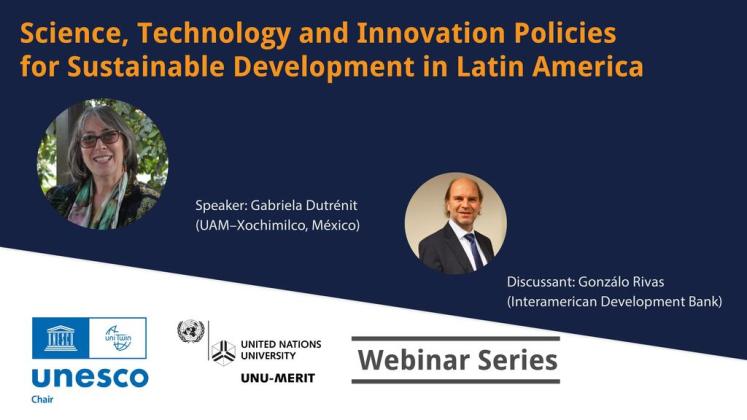During the first webinar of the UNESCO Chair series on ''Science, Technology and Innovation Policies for Sustainable Development in Latin America'', Prof. Gabriela Dutrénit (Universidad Autónoma Metropolitana-Xochimilco, México) gave a presentation on "STI Policy, development strategy and social inclusion". Gonzalo Rivas, Chief of the Competitiveness, Technology and Innovation Division of the Interamerican Development Bank (IADB), acted as discussant. The seminar was held on 6 December, and after the presentation the UNESCO Chair team interviewed the speakers.

How does STI policies help to solve social inclusion problems?
Gabriel Dutrénit: First, I believe that STI policies can only help solve social inclusion problems, but they cannot solve them directly as it is not their main objective. In this sense, I think that the STI policies must have a social inclusion perspective. We started discussing this approach in LALICS meetings since 2014. The social inclusion perspective in STI policies implies the design of a policy instrument considering its social implications from the outset. For example, a wind farm technology policy should include and consider the effects on nearby communities.
The STI policies are sets of incentives that always inevitably have a positive or negative impact on society since neither science nor innovation are neutral. Several times you cannot stop a scientific discovery that could also harm societies, or useful innovations that may also put social groups at risk. However, by including a social inclusion perspective in STI policies, I believe that it is possible to consider the possible positive and negative social impacts and adjust the incentives structure accordingly.
Gonzalo, what do you think are the most important bottlenecks in Latin America to achieving scientific and technological development and social inclusion?
Gonzalo Rivas: I consider that Latin American countries are currently facing three main unavoidable challenges: demand for inclusive policies, climate change and low productivity levels. The first challenge comes from the demand for inclusive policies of the recently empowered middle classes that, after COVID, returned to poverty. Nowadays, the middle classes have multiple ways to express their discontent, especially through social media and digital platforms.
The second challenge is climate change, not only from the point of view of the countries’ need to include a decarbonization path in their development strategies, but also related to the effects of climate change on Latin American economies. For example Chile lost 1.2 percent of GDP per year due to natural disasters during the period 1981-2001, a good part of it due to earthquakes but increasingly due to flooding, firestorms, etc. The third challenge is related to Latin America's low productivity levels, worsened by the fact that many Latin American countries have exhausted the benefits of the demographic bonus. I believe that these three objectives need to be considered when designing public policies. There is no way to face these challenges without a significant contribution of STI policies. As Gabriela mentioned in her webinar, the solutions are political and not technical, but without the necessary technical capacity, it will be impossible to find solutions adapted to the Latin American context. The problems to deal with the effects of climate change and with social inclusion in excluded communities require local idiosyncratic innovations that can only come from Latin America itself. One example is the immigration flows from Central America to the USA. We need investment to generate these local idiosyncratic innovations.
What is your point of view, Gabriela?
Gabriela Dutrénit: I will answer the question from a complementary perspective from Gonzalo’s approach. For sure, companies follow their economic interests, and therefore, it is difficult to avoid many negative effects. Thus, as actors pursue their objectives, it is difficult to associate the development of innovations with a positive impact on social inclusion. This explains why incentives are so important. Effective STI policies need to take due account of specific actors’ incentives. However, with the recent COVID pandemic, we have observed how science can respond fast to non-economic incentives. The awareness of the scientific community and of civil society of the importance of science in the COVID pandemic, prompted a strong and effective reaction and gave research a clear direction. The same goes for diabetes. Even though in the collective imagination the scientific community sometimes seems to be in a glass bell, it showed remarkable social awareness during the pandemic. Hence, the challenge is how to generate the conditions for this social sensitivity to manifest itself more, without abandoning other strategic objectives on which they need to continue research.
At this stage, we are curious to know your opinion on the role that multilateral financial institutions should have in promoting STI policies for social inclusion.
Gonzalo Rivas: I believe that international financial organizations must support investments in science, technology and innovation financially. However, they also need to act as intermediaries to complement good policy practices and favour their exchanges across countries. With the IADB, we do not only provide financial resources, but we also make all possible efforts to learn together with countries in the region, and provide continued support over time, so that these policies are anchored in programs with a longer duration than government mandates, and ensure the necessary continuity.
Gabriela Dutrénit: I am convinced that universities should play a much stronger role in designing countries’ development strategies in Latin America. In the region, most financing for STI Policies goes to universities, that should be more engaged in promoting STI policies and social inclusion within a coherent development strategy.
If you missed out on this webinar, you can also find a recorded version of the presentation here:

